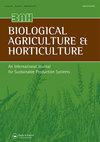芜菁和罗勒间作及施用蚯蚓堆肥和生物炭作土壤改良剂对芜菁作物质量和数量的影响
IF 1.6
4区 农林科学
Q3 AGRONOMY
引用次数: 0
摘要
摘要间作是一种生态友好的技术,可以提高农业系统的可持续性,同时被认为是低投入系统。这项为期2年(2018–2019)的研究旨在评估不同密度饲草萝卜和罗勒植物以及施用蚯蚓堆肥和生物炭的间作系统中饲草生产的质量和数量。处理为:100%饲草萝卜(单作);90%的饲料萝卜+10%的罗勒;80%的饲料萝卜+20%的罗勒;在主地块施用70%的饲料萝卜+30%的罗勒,在子地块施用两个蚯蚓堆肥水平(15和18.5 t ha−1)和两个生物炭水平(0和5 t ha−2)。以70%饲料萝卜+30%罗勒×蚯蚓堆肥(18.5 t ha−1)×生物炭处理,萝卜干物质产量、水溶性碳水化合物、粗蛋白、叶干物质和根干物质生物量的消化率最高。与单一栽培相比,该处理使地上叶和根的粗蛋白质含量增加了94.6%。酸性洗涤纤维和中性洗涤纤维最高的是单一栽培×蚯蚓堆肥18.5 t ha−1×生物炭,灰分最高的是80%的饲料萝卜+20%的罗勒×蚯蚓堆肥185t ha−2×生物炭。将饲料芜菁和罗勒与生物炭和蚯蚓堆肥以18.5 t ha−1的量进行间作,比单独种植蚯蚓堆肥以15 t ha−2的量更可取。可以向农民建议,将萝卜和罗勒与生物炭和蚯蚓堆肥相互种植,作为单一种植的替代方案。本文章由计算机程序翻译,如有差异,请以英文原文为准。
Effects of intercropping forage turnip (Brassica rapa L.) and basil (Ocimum basilicum L.) and applying vermicompost and biochar as soil amendments on quality and quantity of the forage turnip crop
ABSTRACT Intercropping is an ecological friendly technique that can increase sustainability of farming systems, whilst considered as low input systems. This 2-year (2018–2019) study aimed to assess the quality and quantity of forage production in intercropping systems with different densities of forage turnip and basil plants and with application of vermicompost and biochar. The treatments were: 100% forage turnip (monoculture); 90% forage turnip + 10% basil; 80% forage turnip + 20% basil; 70% forage turnip + 30% basil applied in main plots, and two vermicompost levels (15 and 18.5 t ha−1) and two biochar levels (0 and 5 t ha−1) applied in subplots. The highest dry matter yield, water-soluble carbohydrates, crude protein, digestibility of dry matter of leaf and root biomass parts of the turnip were recorded in the treatment with 70% forage turnip + 30% basil × vermicompost (18.5 t ha−1) × biochar. This treatment increased crude protein of the above-ground foliage (by 94.6%) and the root (by 87.5%) of the forage turnip, compared with monoculture. The highest acid detergent fibre and neutral detergent fibre were recorded in monoculture × vermicompost 18.5 t ha−1 × biochar and the highest ash was recorded in 80% forage turnip + 20% basil × vermicompost 18.5 t ha−1 × biochar. Intercropping forage turnip and basil with biochar and vermicompost at 18.5 t ha−1 was preferable to monoculture with vermicompost at 15 t ha−1. Intercropping turnip and basil with application of biochar and vermicompost can be suggested to farmers as an alternative to monoculture.
求助全文
通过发布文献求助,成功后即可免费获取论文全文。
去求助
来源期刊
CiteScore
3.30
自引率
6.70%
发文量
18
审稿时长
>36 weeks
期刊介绍:
Biological Agriculture & Horticulture aims to act as the central focus for a wide range of studies into alternative systems of husbandry, and particularly the biological or organic approach to food production. The Journal publishes work of a sound scientific or economic nature related to any aspect of biological husbandry in agriculture, horticulture and forestry in both temperate and tropical conditions, including energy and water utilization, and environmental impact.

 求助内容:
求助内容: 应助结果提醒方式:
应助结果提醒方式:


